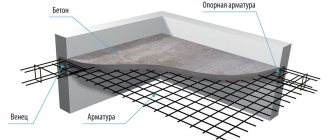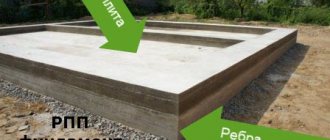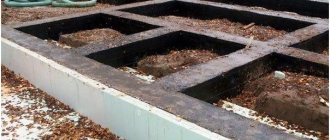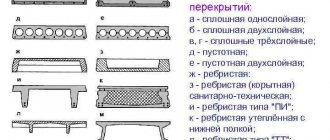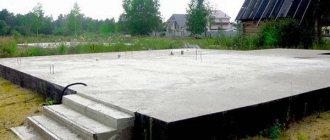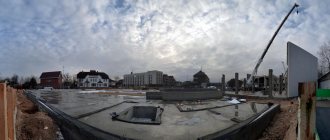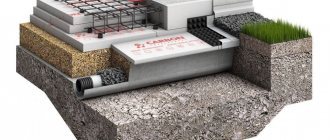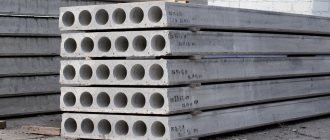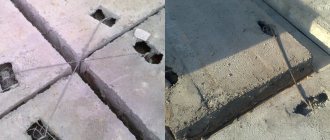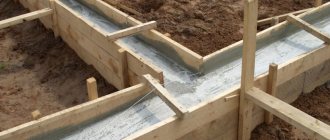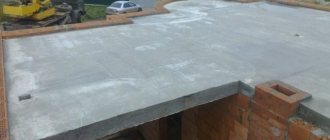The strip foundation is currently one of the most common. This type of foundation is relatively cheap and evenly distributes the load from the pressure of the walls. The strip foundation is universal in use because it is suitable for buildings of different construction technologies. However, the strip base is not suitable for some types of soil. In this case, preference is given to a strip foundation with a monolithic slab.
Construction of a strip foundation with a slab on the ground
Such structures combine the advantages of strip and slab foundations and can be simply represented as a flat box standing upside down.
At the first stage, a strip base is built, and a monolithic slab is poured on top of it. In this case, its edges rest on the tape. As a result, the house itself is located on a slab foundation which, in turn, stands on a strip foundation. As a result, the weight of the building is redistributed, reducing the load on the belt.
The advantages of a slab foundation are reduced to reduced pressure on the ground, due to the larger support area. Such a foundation, when the ground moves, will move along with the building without causing much harm. The strip foundation reduces the likelihood of lateral displacement and is an additional reinforcement of the perimeter of load-bearing walls.
This design makes it possible to reduce the thickness of the slab and the width of the base tape. These elements mutually reinforce each other and allow you to save on building materials.
A guide on how to build a slab foundation for a house
A slab foundation is a type of shallow strip foundation. Externally it looks like a monolithic slab or reinforced concrete lattice located throughout the site under the building. This type of foundation is mainly used for the construction of cottages. Read how the Swedish Slab foundation works and how to build it.
- If the construction is quite light, for example, a garage, then it is necessary to build on the minimum thickness of the slab - 100 millimeters.
Pros and cons of the solution
When choosing a strip base with a slab on the ground, it is worth understanding the pros and cons of such an engineering solution. The advantages include the following factors:
- Increased strength. A reinforced concrete slab can withstand even high loads.
- This type of base is suitable for different types of soil, including clay, peat, loam, as well as high groundwater levels.
- Long service life of the base.
- Such a foundation can be considered the basis for a building with any number of floors.
- The monolithic slab will be the basis for the future floor of the first floor.
However, a strip foundation with a slab on the ground also has its downsides:
- increased consumption of building materials compared to the construction of a conventional strip foundation;
- due to the shallow depth of the foundation, accurate calculations are required;
- High labor intensity of the process due to the need for excavation and concrete work;
- High cost compared to a conventional strip base.
However, in general, expert reviews about this type of foundation are positive; the positive qualities of such foundations outweigh the disadvantages.
Technology of reinforcement of a monolithic floor slab
Despite the constant improvement of construction technologies, a monolithic floor slab will remain the most popular reinforced concrete product for a long time.
In addition to their, of course, high strength, such structures have one important advantage - they can be manufactured independently, which will eliminate the need to use heavy construction equipment, and to a certain extent reduce construction costs.
At the same time, reinforcement of a monolithic floor slab requires careful preliminary calculation, which is carried out by professionals using a computer and special software.
Advantages of self-made floor slabs
Independent “production” of floor trusses is possible directly at the construction site, which invariably results in such advantages as:
Floor slab
- saving time on searching for a manufacturer/seller who offers the most optimal sales conditions;
- no need to hire special equipment for transportation to the construction site;
- there is no need to organize a storage area and involve additional people in unloading;
- the ability to use concrete of any grade, which allows you to create more durable structures compared to factory-made analogues;
- the ability to obtain slabs of any size, including non-standard sizes.
Of course, there are certain difficulties, which include complex calculations to ensure that the reinforcement of the floor slab is carried out according to all the rules, as well as a long waiting period during which the product will dry and also gain the necessary strength. This period takes about a month.
Formwork installation is an important and critical stage of reinforcement
In order to obtain reliable formwork for floors, it is permissible to use all common materials, including the cheapest option - wood. At the same time, special attention must be paid to the racks, since they will bear the main load (up to 300 kg/m2), which requires them to be securely fastened. When constructing formwork, the thickness of the future slab should be taken into account.
Construction of a monolithic slab
So the recommended thickness for interfloor ceilings is at least 70 mm (for industrial premises 80 mm), for coverings 60 mm, under driveways at least 100 mm. You should know that a layer of concrete of 25-30 mm should remain under the lower reinforcing mesh of the slab. To comply with the conditions, plastic or wooden spacers should be secured to the formwork in increments of no more than 1 meter, onto which the lower reinforced belt is placed under the floor slabs.
Rules for self-reinforcement, which must be observed
There are a lot of specially developed technological requirements, compliance with which is mandatory both in the industrial production of slabs and in their independent production. Exact compliance with these requirements will allow you to carry out high-quality and reliable reinforcement of a monolithic floor slab with your own hands.
- In the event that the slab is intended to cover spans more than 8 meters in length, it is necessary to use a tense mesh of especially strong ropes.
- For reinforcement, welded mesh is used with a rod diameter of at least 6 mm (usually 8-14 mm), with a distance between them not exceeding 600 mm.
Construction of floors - The slab is filled with a solution of grade M-200 or higher. The M-350 brand can be considered optimal.
- The percentage of reinforcement of reinforced concrete structures increases in the middle of the slab, in places where increased loads are expected, in places where the slab comes into contact with reinforced concrete supports, and near technological openings.
- With a slab thickness of up to 150 mm, you can get by with one mesh; when pouring a thicker slab, two meshes are used, positioned at the bottom and at the top.
Calculation of a strip foundation with a slab on the ground
To build a reliable strip foundation with a monolithic slab, complex engineering calculations are required. It is not recommended to carry out them yourself without proper knowledge and experience. These works should be entrusted to professional architects. When making calculations, it is necessary to take into account a number of factors:
- Characteristics of the soil on the site, this will require testing;
- Dimensions of the future building according to plan;
- Analysis of the possible tilt of the structure during its operation;
- Calculation of foundation compression;
- Carrying out calculations according to the deformation scheme.
Only taking all this into account can the depth of the strip base, its width, and the cross-section of the monolithic slab be calculated.
Types of strip base
At the first stage of construction, a strip foundation is erected. A trench is dug under it, and a layer of sand is laid along its bottom. Waterproofing is installed on top of the pillow and only after that can you begin to arrange the base itself. Strip foundations can be of two types:
- Monolithic, that is, made of concrete mortar;
- Prefabricated, that is, assembled from reinforced concrete products.
The second option is not used as often, since it requires the use of special equipment. The foundation can also be divided according to the type of burial:
- Shallow - such structures are suitable for one-story buildings or light cottages (frame, timber, foam block). The depth in this case is 0.5-0.7 meters. The soil acidity indicator is also important; it should be low or medium.
- Recessed - this type of foundation is used for the construction of high-rise buildings or when using heavy materials, for example, in the construction of monolithic cottages. In this case, the foundation goes deep 0.2-0.3 m below the soil freezing level.
Road slab foundation: advantages and disadvantages
There are many types of foundations that are suitable for the construction of various buildings, but it just so happens that in our country people are trying to save money at all stages of construction, starting with the construction of the foundation of the building.
If you lay a road slab on a prepared soil base (GOST 21924-84), it will withstand light loads and light buildings
One of the economical options is a foundation made of road slabs, the advantages and disadvantages of which we will examine in more detail.
Construction methods
A strip foundation with a slab on the ground can be of two types:
- With a ground floor;
- Without him.
Foundations with plinth
In the first case, a monolithic slab serves as a ceiling separating the ground level and the first floor. In this case, the construction scheme looks like this:
- The site for construction is prepared, a pit is dug on it.
- A layer of ASG is placed on the bottom.
- The formwork is formed and the reinforcement system is formed.
- The concrete solution is poured.
- The foundation is maintained for 28 days. After this period, continuous formwork is installed, supported by a cut of the strip base. For reliable fixation from below, it is supported by a wooden beam. At the same time, in the formwork it is necessary to consider passages to the ground floor and communications inputs.
- A reinforcement system is installed, a concrete mixture is poured, which is kept until completely hardened.
This technology requires certain experience and skills. The use of ready-made reinforced concrete slabs greatly simplifies the installation of the floor. In this case, the length of the slab in a free position without support from pillars should not exceed 6 meters.
Foundation without plinth
This design involves completely filling the internal space of the strip base. A multilayer structure is formed inside:
- The sand mixture is backfilled using a layer-by-layer tamper.
- A double waterproofing layer is required.
- A reinforcement system is being formed. Since the monolithic slab is supported by its entire area, structural reinforcement is used.
- Concrete mixture is poured. During this process, it is necessary to use tamping equipment. When constructing a private house of a small area, you can use manual rammers; when constructing larger buildings, it is necessary to use deep vibrators.
The concrete is kept for 28 days until it hardens completely.
Laying a sand cushion
The backfill under the slab should be as uniform as possible; it is advisable to use river or quartz sand. It is necessary that there are no clay inclusions in the sand, which will help retain moisture inside. Either complete backfilling with sand or layer-by-layer filling with fine gravel is allowed. The presence of the latter will allow the sand layer to be compacted more strongly. Another sand layer of at least 50 mm is laid on top.
Construction of formwork structure
The formwork is assembled from wooden panels and boards. The height of the structure should exceed the level of pouring the concrete mixture by 100-150 mm. Gaps with a width of no more than 3 mm are allowed. The outer side of the formwork is strengthened with support beams and inclined stops. They will prevent the walls from being squeezed out under the influence of the poured solution. When constructing formwork for the base, it is necessary to first assemble a system of support beams and crossbars. Only after this can you begin to assemble the plane.
A thick film is laid on top of the formwork, which will seal it, preventing the concrete solution from leaking out.
Reinforcement system and grouting
A foundation reinforcement system is formed from steel rods. A mesh with a cell no larger than 200 mm is assembled from them. Two layers of grating are installed with a distance of 100-150 mm from each other. The reinforcement system should be located from the bottom plane at a height of 50 mm. To do this, the bottom layer is placed on timber stands.
The solution is poured evenly over the entire area of the slab. The final layer should overlap the upper reinforcing mesh by at least 50mm. After completing the pouring procedure, the slab is covered with polyethylene to protect against moisture loss. It is also recommended to moisten the surface with water during the first few days. This is necessary to compensate for humidity differences and protects against cracking.
Installing a subfloor on a slab
There are several technologies for organizing a subfloor. Reviews from experts indicate that the most optimal is to create the following design:
- A pillow and sifted sand are laid;
- A “skinny” screed is poured on top;
- A layer of insulation is laid; craftsmen prefer penoplex;
- Another layer of screed 50-70 mm is poured;
- A leveling screed is poured; self-leveling compounds are usually used;
- A finishing coating is laid on top of it.
If the slab is insulated from below, you can use floating floor technology. It involves creating a “pie” from:
- sand mixture, instead of it you can use expanded clay for additional insulation;
- Sheet material is laid on top, it can be MDF, plywood or chipboard.
- A finishing coating is laid on top of the subfloor.
A strip foundation with a slab can become a reliable foundation for a cottage. It is suitable for areas with different types of soil and tolerates soil movements well.
Stages of laying a foundation from road slabs
The process of constructing the foundation of a building from road slabs is similar in its scheme to laying a monolithic foundation:
- First, thermal and waterproofing protection is laid.
- At the next stage, the slabs are laid directly (as tightly as possible);
- The joints between the slabs are filled with concrete (don't forget about the formwork).
- After the joint fill has completely dried, the surface of the slabs is also covered with concrete mortar.
- In the summer, the screed should be periodically wetted (not watered), and also covered with polyethylene until complete setting occurs.
Road slabs are one of the best solutions for building a foundation.
Laying road slabs as a foundation for a garage
Laying the foundation of your future home with their help is quite quick and easy, and the costs mainly relate to the purchase of materials and the use of crane equipment.
